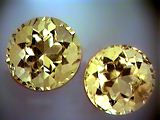![]()
Name:
Scapolite

Chem:
Na4(AlSi3
O8)3
Cl.nCa4(Al2Si2
O8)3(SO4,CO3)
complex sodium calcium aluminum silicate
Crystal:
Tetragonal (usually short prisms with square cross section)
Color:
clear, yellow, green, gray, and rarely violet, blue, or pink
Refrac. Index:
1.54 - 1.58
Birefraction:
0.020
Hardness:
5 - 6.5
Spec. Grav.:
2.57 - 2.74
Fracture:
conchoidal
Cleavage:
perfect (2 directions)
Environment:
a metamorphic product, hydrothermal metamorphic rocks.
Association:
almandine, andalusite, andradite, actinolite, microcline, muscovite
Locals:
| Canada | N.Y., N.J., USA | Brazil | Switzerland | Mexico |
Misc:
The name comes from the Greek "skapos", meaning "shaft" alluding to its common long prismatic form. Often fluorescent orange-yellow. Soluble in HCl leaving silica. Also known as wernerite named for a German explorer.
Gem info:
The transparent varieties are faceted and the less transparent stones may be cabbed yielding some cats-eye stones. The value increases with the darker colors, but it is not an expensive stone.
![]()
2 stones